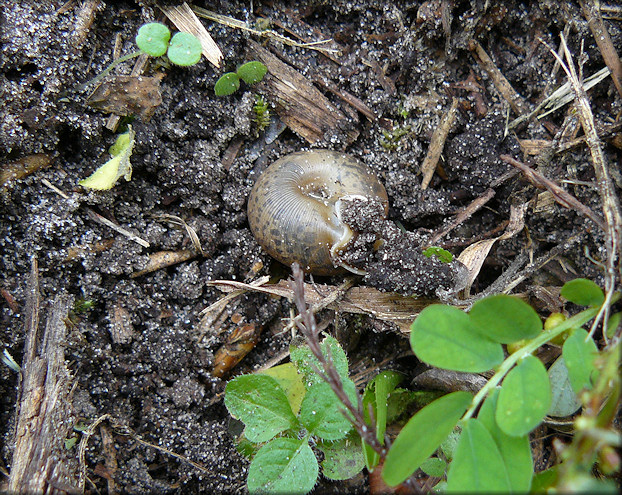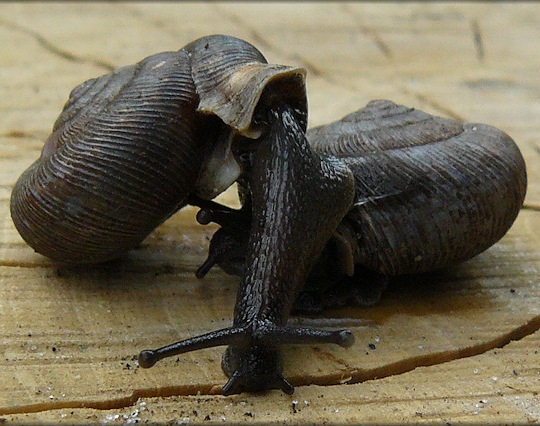Classification
Taxonomic Name: Millerelix jacksoni
Common Name: Ozark Liptooth
Domain - Eukaryota
Kingdom - Animalia
Phylum - Mollusca
Class - Gastropoda
Order - Stylommatophora
Family - Polygyridae
Genus - Millerelix
Species - Millerelix jacksoni (T. Bland, 1866)
The species Millerelix jacksoni was discovered by Thomas Bland in 1866. The species was previously categorized as Helix jacksonii (Binney, 1869) and then as Polygyra jacksoni (Pilsbry et al, 1906) before finally being classified under Genus Millerelix.
Below is a description of the taxonomy of Millerelix jacksoni. It starts out with a description of the domain Eukaryota and funnels down to the exact definition of the Genus Millerelix and the species epithet jacksoni.
Domain Eukaryota: Formed from symbiogenesis where the mitochondria and chloroplasts developed when a eukaryote engulfed an aerobic bacterium (Hickman et al, 2012). Members have a nucleus, nucleolus, and other organelles (Hickman et al, 2012).
Kingdom Animalia: Also known as Metazoa and consists of the invertebrates and vertebrates; protozoans are not included within this kingdom (Hickman et al, 2012). They are multicellular, heterotrophic organisms that ingest food within their body or absorb nutrients by parasitic means (Hickman et al, 2012).
Phylum Mollusca: The largest and most diverse group of animals with about 70,000 living and 15,000 fossil species that have bilateral symmetry (body split down the middle into equal halves) (Hickman et al, 2012). This group consists of snails, slugs, octopi, squids, etc. which are all bilateral (Hickman et al, 2012). Most have an external, hard shell (with the exception of slugs and the Class Cephalopoda, i.e. squid, octopus, etc.), soft non-segmented bodies or an internal skeleton, a mantle which produces the shell and houses the internal organs, and mucous/slime glands (Burch, 1962). A large “foot,” present in many species of this phylum, is used for movement, digging, and capturing prey (Burch, 1962). Members of Mollusca are found in various regions and habitats throughout the world. Some members are aquatic, both freshwater and marine, while others are terrestrial and live on land (Burch, 1962).
Class Gastropoda: The largest and most diverse
group of mollusks, which includes snails and slugs (Burch,
1962). Gastropods can either live in a terrestrial environment
or aquatic environments (both marine and freshwater). They have
preserved their mucous foot, but have undergone torsion within their
bodies (Burch,
1962). This means that the anus lies near the head of the snail
(Burch,
1962).
**For more information on torsion, please see the
Adaptations page.
Order Stylommatophora: Members of this order have two pairs of tentacles that have eyes at the tips of the upper pair (Hickman et al, 2012). The tentacles can be retracted or withdrawn when the snail feels threatened (Burch, 1962). Snails and slugs are air-breathing, terrestrial organisms that are divided into suborders based on their internal structure and the placement of these internal structures. The two organs most looked at are the kidneys and liver (Burch, 1962).
Family Polygyridae: This family contains medium to large snails with lips and tooth-like structures called denticles (Burch, 1962). These snails live in mild, temperate climates ranging from Alaska and eastern Canada to the tropics in the south (Burch, 1962). These snails are typically terrestrial snails that reside in humid environments (Burch, 1962).
Genus Millerelix (Prattelix): A genus of terrestrial snails derived from the Family Polygyridae (Pratt, 1981) due to adjustments made in the classification of anatomical, behavioral, and shell characteristics as well as shell, penial, and reproductive-system morphology (Emberton, 1994). The snails in this genus have shells with hairs that are rounded and slightly curved at the tip (Emberton, 1994). The hairs are easily broken and located behind the lip of the snail’s shell and in the umbilicus, or depressed, region of the shell (Emberton, 1994). The snails of the genus Millerelix have shells with whorls that increase in size as coiling continues, much like a tiered wedding cake. Each whorl is then almost equal in volume (Emberton, 1994). The shells have either a U- or V- shaped denticle (tooth-like projection) and have a narrow notch/nick near the denticle (Emberton, 1994). For the reproduction-system these snails have no flagellum on their vestigial epiphallus, an enlargement of the vas deferens (Emberton, 1994). They have an extremely long and slender penis with a width <0.06 length. For the subgenus Prattelix, which includes Millerelix jacksoni, the vas deferens are muscular and larger than those of other snails (Emberton, 1994).
Species epithet jacksoni: The species was discovered by Thomas Bland in 1866 (Pilsbry et al, 1906). The width of the shell ranges from 7mm – 9.3mm with anywhere from 5 & 1/2 to 6 whorls (Burch, 1962). The whorls are pale or dark horn-colored, typically light or dark tan (Burch, 1962). The species has a small umbilicus, or bellybutton like depression, that is 1/5 or 1/6 the size of the shell diameter (Burch, 1962). These snails commonly reside in Missouri, Arkansas, and Oklahoma (Burch, 1962).



